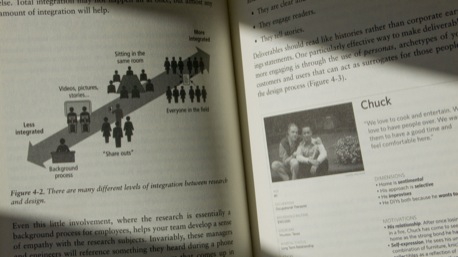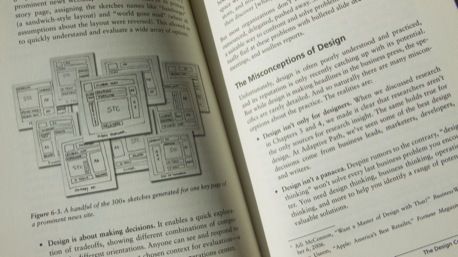Subject to Change: Creating Great Products and Services for an Uncertain World
(Guest Review by David Sherwin)
Underwhelmed.
We’ve all had this reaction when encountering a product or service that just didn’t cut it.
Take, for example, the alarm clock next to my bed. There are two alarm switches side by side: one for me, and one for my wife. Invariably, every morning I hit the wrong switch and the alarm keeps sounding. By the time I’ve shut the thing down, my wife is wide awake. And she goes to work two hours after me…
I kept thinking about my alarm clock while I was reading the all-too-brief Subject to Change: Creating Great Products and Services for an Uncertain World (Amazon: US


Adaptive Path (AP) is well known as one of the global leaders in providing product experience strategy and design services. As part of their overall business strategy, AP provides training and events to help educate designers, managers of design, and business executives on many of the topics of discussion in Subject to Change.
I have read and loved most of the other books written by AP staffers, such as The Elements of User Experience and Designing for Interaction. They have been formative, in every sense of the word.
So why am I comparing this book to my alarm clock?
Reason #1: This book is a wake-up call for any business executive that has no idea how to address product or service experience issues.
Or, as Jesse James Garrett puts it in the foreword,
“The key to creating successful products and services in a rapidly changing world is not resistance to unexpected change, but the flexibility to adapt to it. That flexibility must take a number of forms: flexible design processes to adapt to new insights into user behavior, flexible development processes to adapt to new technological opportunities, and flexible decision-making processes to adapt to new and competitive market realities.”
From reading this book, readers will gain a holistic approach towards how they can handle experience considerations across the delivery of their company’s products and services. What I found especially bold was the authors’ foray into cultivating empathy as a core attribute of fostering business success. The following paragraph precedes a discussion about moving beyond tasks and goals to fostering considerations of behaviors and motivations in the course of planning a product or service experience:
“Taking a more holistic, experience-focused approach to design means taking a more holistic view of people. What we need are frameworks and terminology that are closer to the ways people talk about and live their lives. To understand people as people, our understanding of our customers and users must better match our understandings of ourselves. After all, our customers aren’t so different from us when it comes down to their basic motivations and behaviors. Recognizing them is an important step toward empathy with our customers.”
Who can disagree with that? Who doesn’t want more empathy with their customers?
(Click to enlarge)
Reason #2: You hear the signal of the alarm loud and clear… and that’s all that you hear.
Subject to Change contains many descriptions of how to empathize with customers, conduct qualitative research over purely quantitative research, make research actionable, foster best-in-class design principles within your enterprise, and practice agile design and development methods as a foundational component of crafting your products/services.
As an example, here’s one that I admired about the power of tangible, designed ideas in the process of driving innovation:
“Strategy is about choosing in which small set of activities and capabilities your organization should invest so that the resulting offerings create a sustainable advantage. Prototyping at the intersection between your organization’s capabilities and customers’ lives lets you model an experience that customers will love, the plan backward through organizational processes and operations to figure out how that experience can be delivered…
Fabricating ideas makes them plainly visible and accessible to evaluation, implementation, improvement, and delivery. But planning a system for finding and deploying ideas can take an organization to the next level.”
This section is followed by a longer discussion of how to create what the authors call The Long “Wow!” As designers, this idea of the repeated “Wow” for our client’s customers – and in how we serve our clients as well – is a valuable way to think about approaching the results of our design thinking over time. You can sell the author’s high-level thinking here to your boss without much struggle.
But then the tires need to hit the road. This book is all description and narrative. It is intentionally devoid of any actionable tools to dive into implementation. At the end of the book, there are references for all the quotes and material referenced in the text, but no next steps for how you can dive into, say, implementing agile methods as part of your business practice.
(Click to enlarge)
For AP’s focus on paid education and training as part of their service offering, I found this omission to be quite telling. This book is not quiet in its evangelization of AP’s methodologies, products, and services. It is peppered with brief case studies drawn from their overall practice. Yes, these guys are definitely the pros when it comes to thinking about this stuff. But you won’t find much content here that will let you dive right into doing it.
Reason #3: To improve the alarm clock, the manufacturer should have prototyped the alarm clock with users. Then I wouldn’t wake up my wife so often…
I really wish that Adaptive Path had prototyped the final book content and design to match how they present the material in the real world.
When Subject to Change was coming out, a friend forwarded me a video that had been filmed at Google. Two of the authors, Brandon Shauer and David Verba, gave a 45-minute presentation that I found quite persuasive. It stuck with me for some time.
Upon reading the book, with its dry tone, flat business book-style layout, and poorly reproduced black and white illustrations, I kept thinking about how I had extracted more value from the video. In person, they had much stronger visualizations of concepts like the Long “Wow!” The authors also went into a level of detail about third-party case studies, such as descriptions of the processes involved in creating Target’s ClearRX and Nike+, that were sorely lacking in the book.
(Click to enlarge)
Don’t get me wrong. I’m glad that I read Subject to Change. This book added a level of nuance to my thinking as a manager of user experience. In client meetings, I found myself bringing up points from this book that helped me to steer and guide conversations away from features and poorly thought out goals (a.k.a. “We need a blog because our competitors have one”) to much broader considerations of their overall service experience. It also helped me start a dialogue within my own company about being more agile in how we practice design.
But I will shave down that kudo with a caveat. This book is only a starting point, and in order to advance your business practices as described in this book, you’ll need to scavenge your own toolkit of working methods.
And I know a great company that can help you with that…
If you found this review helpful, you can support The Designer’s Review of Books by buying Subject to Change from Amazon (US


Already read it and have a different opinion? Let us know in the comments.
About the Reviewer
David Sherwin is Sr. Art Director, UX Strategy at Worktank in Seattle, Washington. He maintains the blog ChangeOrder: Business + Process of Design and is writing a book about concepting for HOW Design Press.





